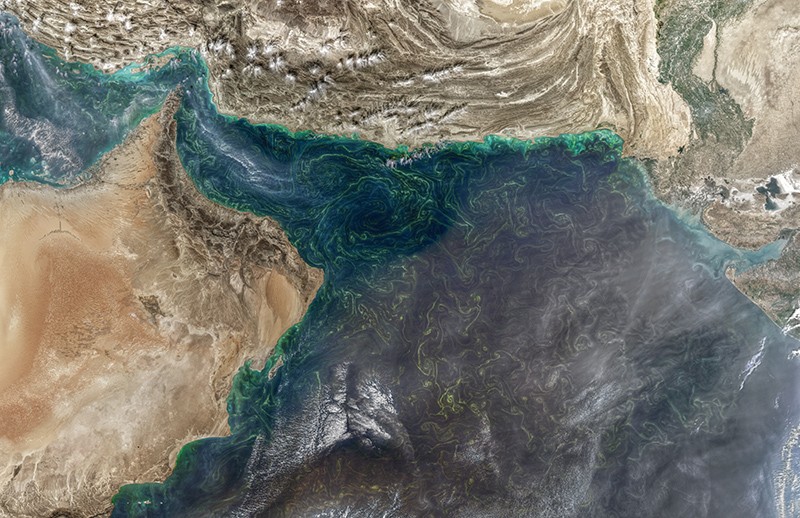Massive blooms of a marine organism called Noctiluca scintillans are currently threatening fisheries, tourism and desalination plants in the Arabian Sea. But scientists are developing forecasting models that could help countries in the region such as Oman predict when conditions seem ripe for a boom in these single-celled creatures, so that they can be better prepared.
The goal is to produce a mostly automated system that works like a weather forecast. It would ingest data on atmospheric and ocean conditions and kick out regular seven-day bloom forecasts — which would be available to businesses, governments and scientists.
Such a system could also help researchers to understand the spread of plankton blooms in the Arabian Sea and beyond in the decades to come, says Joaquim Goes, a biological oceanographer at the Lamont-Doherty Earth Observatory in Palisades, New York, and leader of the modelling project. The blooms might provide a short-term boost to some commercial fisheries, but marine biodiversity could ultimately decline if Noctiluca continues to grow and dominate the ecosystem, he says.
The project is one of several efforts around the world to develop models that can be used to understand and forecast harmful algal blooms. As early as this year, the US National Oceanic and Atmospheric Administration (NOAA) expects to launch its first operational forecast for a toxic plankton bloom called a red tide in the Gulf of Maine using a similarly advanced model, says Richard Stumpf, an oceanographer with NOAA in Silver Spring, Maryland.
Simulating, and ultimately predicting, such blooms is a difficult problem, Stumpf says, because researchers have to understand not just local water chemistry and ocean circulation but also the behavior of different plankton species.
Boom and bust
A huge bloom in the Arabian Sea that began in November 2017 is only now winding down. At its peak in January, it covered an area three times the size of Texas. “Noctiluca is completely overwhelming the system,” says Goes.
Goes and his team spent five weeks in Oman in January and February this year collecting samples and talking to local fishermen as well as industry and government officials. They discussed the forecasting system and learned what kind of bloom prediction information community members would need.
Although Goes’ current forecasting model is promising, the team hopes to improve its resolution and to incorporate information on Noctiluca’s tricky biology.
This minute organism has both plant and animal characteristics. It is a predator that thrives in the low-oxygen waters that have become more common in the region1. But, much like corals, Noctiluca also has a symbiotic relationship with algae that live inside the cells. These algae contain the green pigment chlorophyll, which sensors on satellites can monitor from space, enabling researchers to track the blooms.
It’s unclear why major Noctiluca blooms now occur in oceans around the world, including in the Arabian Sea and the waters off India, Thailand and Indonesia. Researchers suspect that the release of raw sewage, which provides nutrients, and global warming may have roles.
A growing problem
The right conditions can stimulate Noctiluca blooms so thick that when the creatures die, their decomposing bodies suck most of the oxygen out of the seawater. In years past, the bloom’s expanding low-oxygen zone pushed sardines in search of oxygen onto some beaches in Oman; aquaculture farms have also been impacted by these zones.
This year, desalination plants, which draw in seawater, had to scale back their activities to prevent Noctiluca from physically clogging their systems.
The current model devised by Goes and his team for the Indian Ocean has a resolution of 3.5 kilometres. It’s able to forecast the bloom potential of two classes each of plant and animal plankton. The model reproduces the behaviour of the current bloom in the Arabian Sea fairly well, but it’s not yet good enough to produce a useful forecast for a local shrimp farm or a desalination plant, says Sergio deRada, an ocean modeller at the Naval Research Laboratory at the Stennis Space Center in Mississippi.
The next step is to boost resolution to 1 kilometre or even 500 metres, and to represent Noctiluca itself in the model. The problem, says deRada, is that Noctiluca acts like both plant and animal plankton, which means that its behaviour is more complex than the plankton currently included in the model. “That’s why modelling it is going to be tough.”
Sign up for the daily Nature Briefing email newsletter
Stay up to date with what matters in science and why, handpicked from Nature and other publications worldwide.

No comments:
Post a Comment